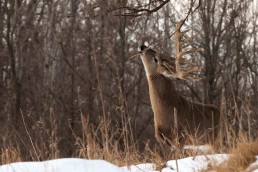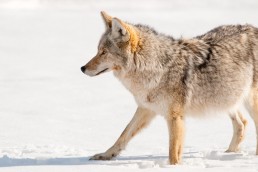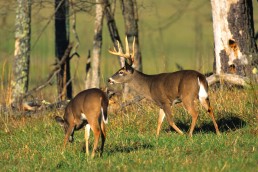The Endgame: Tactics for Late-season Bucks
SHARE THIS POST
The flurry of peak-rut may be over, but bucks are still ready to breed at the drop of a hat. Any sign of a receptive doe can encourage them to go berserk again. In some areas, not all the does get successfully bred the first try, or the second time for that matter. Some people call it a “secondary rut.” It’s a fact that sometimes a few does will make it through a couple of estrus cycles before being effectively bred. This often happens in areas where there are too many does.
If there’s snow during this time, their food sources become limited, as all the chlorophyll has dropped from the plants and crops have been harvested. With snow, their tracks are much easier to see and favorite travel routes become obvious.
After all the does are bred, whitetails will start to reform their social structures. The bucks start to tolerate each other more and the does start to socialize in their doe-fawn family groups. The alpha-grandmother doe slowly starts to become the dominant deer in the area again. Many times, if the snow is early enough, you can catch them going into their winter patterns while there’s still time left in the season.
On the other hand, sometimes they’ll totally vacate an area for one that will sustain them during the harsh months ahead, often referred to as “deer yards.” Look for areas with conifer trees and thicker brush to protect them from the elements and plenty of browse species. They are predictable in their winter patterns, but either way late season is my favorite time to hunt.
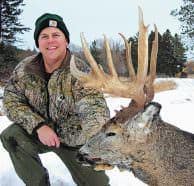
Some hunters feel that all their scouting was done earlier in the year and that now is the time to reap the rewards. While I somewhat agree, I put in just as much time scouting during late season as I do any other time of the year. Things change dramatically in the whitetail’s world during December and January, and it’s important that you stay on top of the changes.
Late season is a great time to intercept bucks cruising for that last receptive doe. Estrus scents, like Special Golden Estrus or breeding scents like Active Scrape, can work well. A couple years ago in a December, I was fortunate enough to harvest a nice 6 x 5 by placing out four scent wicks soaked with Special Golden Estrus. Once he got about 70 yards downwind of the scent, he came right in with his nose waving in the air.
Are you enjoying this post?
You can be among the first to get the latest info on where to go, what to use and how to use it!
Although there are many scent scenarios that you can create, during late season your application methods are a bit more limited. In deep snow, scent trails are more difficult to create. Just simply luring deer from downwind with scent-soaked wicks is a simple method to use. Place out your wicks at your maximum confident shooting range crosswind from your position, so you’ll lure in deer from downwind before they get “straight” downwind from you.
Most hunters put away their Magnum Scrape Drippers because they will freeze-up—that’s true if you have freezing temperatures and you still hang them in the shade. However, if you hang them directly where they will receive the daytime sun, the dark dripper cover and black dripper hose absorbs the heat from the sun and will continue to drip even with nighttime temperatures in the 20s. Make sure to leave plenty of space in the dripper’s bottle—don’t fill it up. About 2 ounces is the most that I would suggest during late season. A Magnum Dripper really increases your available tactics for this period.
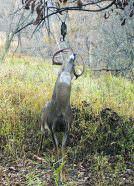
Decoys can be another tool to deploy during the “eleventh-hour.” Since throughout this time whitetails are trying to increase their weight and fat reserves to help them through the dead of winter, they spend a lot of their time “putting on the feed bag.” Thus, we often end up hunting their food sources like a plot of brassicas or agricultural field. This makes the perfect situation to use a decoy. The purpose of a decoy is “to be seen” and food plots and other open areas with long lines of sight provide the perfect opportunity.
Mature bucks will often swing downwind of their supposed “motionless herd companion” before closing the distance, so I will sometimes use scent around the decoy to help seal the deal. Some Golden Buck or Golden Doe, depending upon the scenario you’re presenting, can be a big confidence builder. I will occasionally use a small buck standing over a bedded doe,resembling a buck chasing a doe and they’ve taken a breather for a minute. Some Special Golden Estrus on a Key Wick in close proximity to the doe decoy can be the last thing your buck smells.
Don’t put the scent directly on the decoy; put it on a wick and place it in close propinquity. Otherwise, you have to scrub down your decoy every time you use it because it smells like last week’s urine. Keep the decoy as scent-free as possible and place your scent on a wick, it’s much easier.
This time is special to me: The last gun hunter has passed through, the crops are down and many times there’s a blanket of snow covering the ground. The foliage is off the trees, deer are reforming their social structures and tracks are easy to pick up in the snow. Late season can be the time to catch up with a true “wall-hanger.”
MWO
SHARE THIS POST
Did you enjoy this post?
You can be among the first to get the latest info on where to go, what to use and how to use it!
Todd Amenrud
Todd Amenrud is a full time sportsman whose passion is bowhunting whitetails. He spends considerable time researching whitetails, and has written six books on the subject. Harvesting 47 record-book animals and his ability to share his knowledge have made him one of the Midwest’s most-recognized hunting resources.
